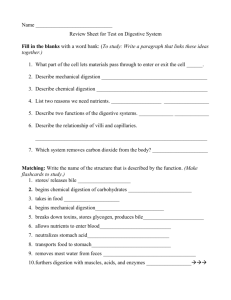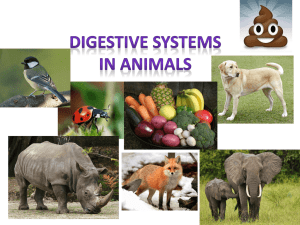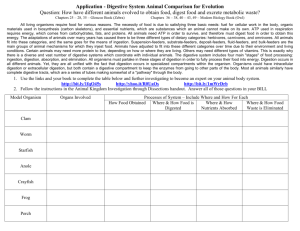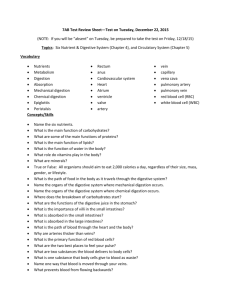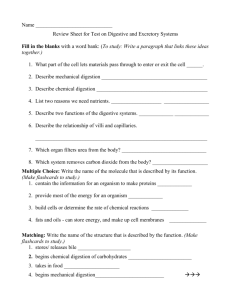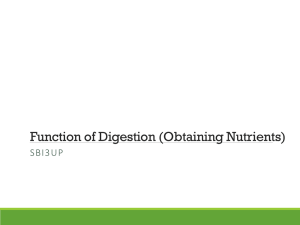Feeding and Digestion - Cal State LA
advertisement
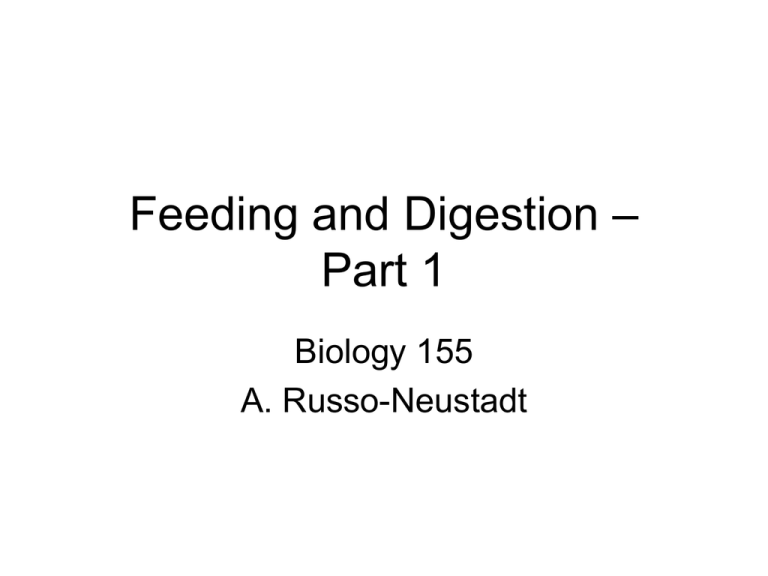
Feeding and Digestion – Part 1 Biology 155 A. Russo-Neustadt I. Definitions A. Ingestion = to bring food into the digestive system B. Digestion = to break food down into smaller molecules that can be absorbed by the body 1. Mechanical – physical, makes use of chewing, grinding, etc. 2. Chemical - makes use of enzymes C. Egestion = elimination of non-digestible materials II. Feeding Mechanisms: A. Feeding on food dissolved (stays in solution) in the environment – 1. Rare 2. Animal takes up food across body surface 3. No need for a digestive system (Note that this mechanism is not mentioned in the textbook.) Examples a. Tapeworms - Marine invertebrates Fig. 21.1C B. Feeding on liquids – Lapping Nectar as food source (also hummingbirds) Sucking 1. Requires a specialized mouthpart to obtain fluids 2. Mouthparts are adapted for sucking or lapping 3. Other examples – Plant sap – aphids Blood – mosquitoes and vampire bats Milk – young mammals C. Filter Feeding = feeding on small particles suspended (will settle out) in the environment Fig. 21.1A 1. Must be aquatic 2. Requires specialized straining device 3. Continuous feeders c. Other examples – baleen whale, mollusks 4. Indiscriminant feeders a. sponges D. Feeding on Large Particles – 1. Requires elaborate sensory systems to find prey 2. Requires elaborate motor systems to capture prey 3. Discontinuous feeders 4. Highly selective Ex. Fish to mammals, insects Figs. 21.1B (substrate feeders) and 21.1D III. Intracellular versus Extracellular Digestion: A. Intracellular = engulf (phagocytize) food particle and isolate it in a food vacuole inside a cell; digestive enzymes are secreted into the vacuole, where chemical digestion occurs Problem = food must be smaller than a cell Ex. Sponges and single celled organisms III. Intracellular versus Extracellular Digestion - continued B. Extracellular = digestive enzymes are secreted into a cavity where chemical digestion generates small molecules that can be absorbed into the body Advantage = can eat things larger than the size of a single cell 1. Gastrovascular Cavity = Incomplete Digestive System Problem = ingestion and egestion occur at the same site, thus regional specialization is impossible which reduces digestive efficiency Ex. Jellyfish and their relatives (shown) Flatworms (not shown) Fig. 21.3A 2. Complete Digestive System = a True Gut, system with both a mouth and an anus Advantage = one-way traffic of food bolus, thus regional specialization is possible which increases digestive efficiency Ex. Roundworms (shown here) through mammals (not shown) Fig. 21.3B IV. Example of a Generalized Complete Digestive Tract: Salivary glands Oral cavity Mouth esophagus Fig. 21.4 liver Stomach or crop and gizzard Gall bladder pancreas Large intestine Small intestine Anus


